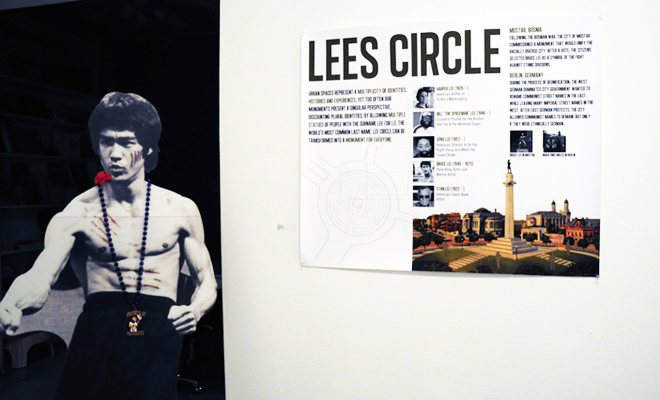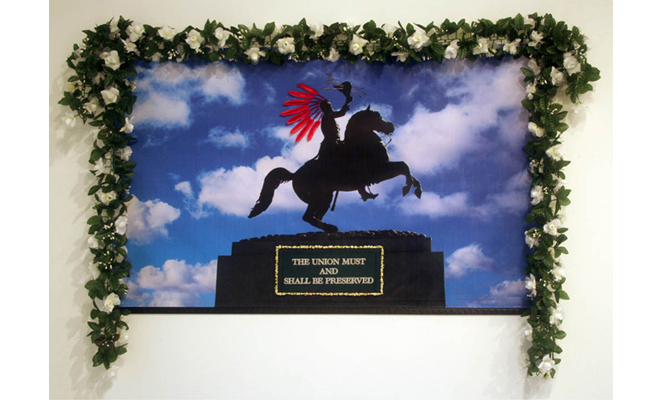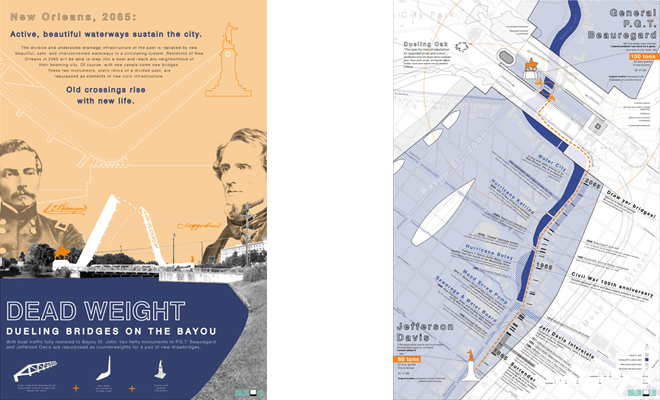Last Call: “monu_MENTAL” at Antenna Gallery
It’s the last weekend to catch “monu_MENTAL,” curated by Courtney Egan, at Antenna Gallery. Before it’s gone, Charley Cameron reviews.

Zakqc Lockrem, Lees Circle, 2011. Printed proposal with life-size cutout. Courtesy the artist.
New Orleans frequently incurs the terms “reimagine” and “reinvent” as developers and residents seek to modernize and bring new life to dilapidated (and sometimes not so dilapidated) sections of the city. In “monu_MENTAL,” curator Courtney Egan asks artists to contribute to a psychogeographical exercise reevaluating the grandiose granite and bronze statues that tower over parks and neutral grounds.
The resulting group exhibition figures both the role of the monument and those memorialized in an altogether more democratic manner. The works seek to reveal the darker sides of the city’s former idols and even replace them with largely unsung heroes, suggesting that we might instead look to new models of leadership. The show also asks the most fundamental question: What does a monument in all its ostentatious glory stand for?

Rajko Radovanovic, Red Father, 2012. Mixed media. Courtesy the artist.
Unsurprisingly, the statue of Andrew Jackson in the center of Jackson Square is the target of many of the show’s pieces. Rajko Radovanovic’s Red Father, 2012, transforms the seventh President into a Native-American warrior by adding a red-feathered headdress to a silhouetted image of the monument. Three comically placed arrows through Jackson’s hat carry a more serious message of the mortal risks undertaken by the Native Americans who fought his ethnic cleansing policies: Radovanovic’s written proposal informs us, “The opposite of victory is misery and suffering…If that is so, let’s remember all of those who ‘helped’ these victorious horsemen on their journey to the pedestal.”
Stephen Duplantier’s Jackson bears an aggressive critique, in photo-manipulated format, of traditional monuments as phallic representations. In Generally Anti-Jackson, 2011, Jackson, here dubbed the “Stalin of the West,” sits astride a stallion, equipped with an erect penis that would “squirt water to cool children in the Square.” Duplantier’s perversely posed Jackson continues to literally piss on future generations.
The suggestions of alternate icons for contemporary New Orleans are varied. The most populist of these comes from Zakcq Lockrem, who takes his cue from Bosnia’s statue of Bruce Lee. Lockrem’s design poster proposes that Lee Circle become Lees Circle,a “monument for everyone,” where we might honor Harper Lee, Bill Lee, Spike Lee, and so on. While Monument to the Unknown Alien that Helped Rebuild the City of New Orleans, 2012, by Luis Cruz Azaceta, presents a coy drawing of a shirtless worker atop a huge brick-fashioned pedestal, a shovel in his left hand and a hammer totally replacing his right. The surreal protagonist playfully, yet disturbingly, references the place of extreme social and cultural “otherness” that Central and South American migrants have occupied after coming to New Orleans since 2005.

John Kleinschmidt and Andy Sternad, Dead Weight: Dueling Bridges on the Bayou (Part 1 and Part 3), 2011. Digital prints. Courtesy the artists.
In the end, John Kleinschmidt and Andy Sternad provide the most succinct statement on how our monuments should be reinterpreted. Three posters in the style of a developer’s marketing push suggest that in 2065 we could have Dead Weight: Dueling Bridges on the Bayou. The pair imagines a city where Bayou St. John has been turned into a useful, navigable waterway, extended so that one could just hop in a boat and easily commute between New Orleans’ neighborhoods. Meanwhile, the monolithic monuments of Jefferson Davis and General P. G. T. Beauregard are recycled into counterweights for drawbridges across the Bayou. The warring generals rise and fall in perpetuity, enabling New Orleanians to go about their business, while the relics never actually meet, never touch, are never free to have a symbolic “fight.” Just as statues were melted down for munitions in World War II, here the statues are recognized as dead weight, of little cultural use to the city, repurposed to enable functional development—the truest form of beautification of this city.
Editor's Note
“monu_MENTAL” on view through March 4, 2012 at Antenna Gallery (3161 Burgundy Street) in New Orleans. The exhibition is open Saturday and Sunday, 12–5 pm.



